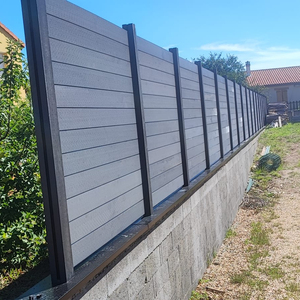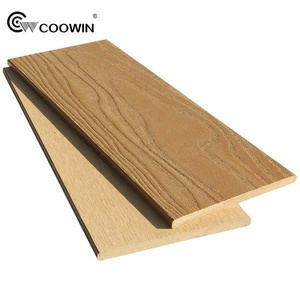
All categories
Featured selections
Trade Assurance
Buyer Central
Help Center
Get the app
Become a supplier

(6139 products available)







































Wooden slat fencing typically comes in distinct types, each for aesthetic and functional considerations.
Horizontal slat fence design consists of slats arranged horizontally. It gives homes a contemporary, sleek look. This style provides good privacy since the slats are spaced closely together. It also demands more effort during installation due to the need for precise leveling of the supporting rails. When viewed from a distance, the horizontal pattern can make a yard feel wider than it is. Hence, it is popular in small residential spaces.
As the name suggests, vertical slat fencing features slats installed upright. It offers a more traditional appearance. This style provides better airflow and is easier to install since the slats are mounted onto horizontal supports. People combine vertical slats with wider spacing to improve ventilation. Sadly, this narrower spacing loosely placed can reduce privacy and security for homeowners.
Angled or diamond-shaped slat fencing incorporates slats set at an angle. This design choice offers a unique and more modern twist to traditional slat fences. The slats can be oriented either vertically or horizontally. However, the angular positioning gives the fence a distinct, contemporary look. It achieves good balances between privacy, security, and style.
These fences come with unique designs, patterns, or finishes to enhance the appeal of an outdoor space. This category includes slat fencing with engraved patterns, different slat shapes, or artistic post supports. This design provides functional barriers and boosts aesthetic value. They also allow for increased personalization to match the unique taste of outdoor space owners.
The wooden fence design plays a key role since slat fencing will influence both function and form.
The configuration of the slats impacts the appearance and practicality of fence design. Horizontal and vertical slats are the most popular configurations. Horizontal slats will give a more modern feel to the surrounding. Vertical slats, on the other side, offer a more traditional outlook. Angled slats provide a unique appearance. People prefer closely spaced slats for better privacy. Luckily, many options cater to people’s needs for privacy and style.
Slats attach to posts via rails or supports. The type of post-and-rail structure significantly impacts the durability and stability of a fence. People make the posts from various materials, including timber-free wood, concrete, and metal. Wood is commonly used due to its natural aesthetic appeal. The size and shape of the rail will affect the overall strength of the fencing. Larger rails improve stability. It also ensures slats remain secured, even under adverse weather conditions.
Coatings protect the wood from water, UV radiation, and pest damage. Also, they affect the color and texture of the wooden fence. Popular options for coating include pressure treatment, painting, and staining. Pressure treatment helps wooden structures resist weather elements. Fortunately, staining enhances the natural wood grain while providing moisture resistance. Painting creates a mini wooden picture where users can choose from countless colors. It also helps extend the lifespan of the fencing system.
Gates are a critical component of wooden slat fences. However, fences frequently lack parameters in the outdoor area. Therefore, a well-designed gate complements the overall appearance and enhances functionality. People can install gates in different styles. These styles include single, double, or sliding designs. The selection mainly depends on the space available and the aesthetic users prefer.
The materials used to make wooden slat fence significantly impact its strength, longevity, and maintenance requirements.
Manufacturers make wooden slat fences from softwoods like cedar, pine, and redwood. They select cedar due to its natural resistance to moisture, rot, and insects. It makes it an excellent choice for outdoor use. The redwood fence is also similar to a cedar fence but slightly more expensive. It comes with a rich color and fine grain. Sliding barn doors are made from pressure-treated pine that is more affordable. It is highly resistant to wood decay. For premium options, go for hardwoods like oak and teak. They are durable, but the cost will be higher.
Manufacturers make engineered wood fences from composite materials that combine wood fibers and plastics. The option enhances durability and reduces maintenance needs. It resists rot, pests, and weather elements far better than natural wood. While not totally wood-like in appearance, they offer a more sustainable option.
The durability of a wooden slat fence mainly depends on the type of wood used and the weather elements. People living in areas with extreme temperatures or high humidity must think about this factor when choosing materials. Regular maintenance, such as staining or painting, is essential to extend the fence's lifespan. Additionally, using quality hardware, including screws and brackets, will help keep the structure intact for many years.
The environmental impacts related to wooden slat fences are twofold. Natural wood harvesting can lead to deforestation and habitat loss. Conversely, engineered wood fences have a smaller environmental footprint. They utilize recycled materials, thus contributing to sustainability.
Wooden slat fences suit different situations, making them a valuable choice for residential and commercial uses.
Certain elements like privacy, security, and aesthetics play a vital residential role in using wooden slat fences. Homeowners choose these fences to define their outdoor spaces, enhance curb appeal, and create a serene environment from neighbors and passersby. The natural look of wood integrates well with landscapes, offering a visually appealing barrier.
Urban dwellers looking for a balance between privacy and city views prefer wooden slat fences. These fences provide enclosures in densely populated environments. Thus, they create a sense of retreat amidst the hustle and bustle. Vertical slats provide good airflow while maintaining a level of privacy. Urban fencers pick composite wood slat fences for their low maintenance.
Commercial properties also often use wooden slat fencing. They provide enclosure for outdoor spaces like patios, seating areas, or gardens. Businesses also use them to create visually appealing barriers that promote brand identity. For example, a rustic-themed café may use wooden slat fencing to enhance its country-style aesthetic.
In rural and agricultural areas, wooden fence designs are useful for livestock enclosures, protecting crops, or defining property boundaries. They are a traditional fencing choice for farms. They safeguard animals while allowing natural ventilation. Besides, wooden slat fences preserve the natural scenic view, keeping the farm outlook attractive.
Public parks, gardens, and recreational areas employ wooden slat fencing to manage foot traffic, protect sensitive areas, and enhance the landscape. They provide barriers while allowing beauty in as part of their ecological and aesthetic value.
While selecting the ideal wooden slat fencing for clients, suppliers should pay close attention to a range of factors.
High-quality wood significantly affects the longevity and strength of the slat fencing. Suppliers should choose naturally durable woods like cedar, redwood, or teak. For clients who hope to use a budget-friendly option, suppliers can recommend pressure-treated pine. They treat it to resist decay and insects, making it a cost-effective long-lasting option.
The design of the fencing style would determine the overall appearance and functionality of the slat fencing. Suppliers should select horizontal, vertical, or angled slats based on current market requirements. They should also consider decorative slat options that provide additional visual appeal. The various styles are suited for different architectural designs. Therefore, suppliers should choose styles that suit various residential and commercial customers.
Suppliers should factor in the maintenance needs of the fence when selecting wooden slat fencing. For clients who prefer a low-maintenance option, they should recommend composite or pressure-treated wood. These materials are relatively easy to maintain. They require minimal frequent staining or sealing. Conversely, if clients are willing to invest time in upkeep for a more authentic look, suppliers can recommend natural wood.
The budget available will determine the type of wooden slat fencing that will be acquired. Although wooden slat fencing offers a timeless natural aesthetic value, it can be relatively costly. Composite slat fencing will provide a more budget-friendly option. The option will also be long-lasting. When working with tight budgets, suppliers can recommend pressure-treated wood as a more economical alternative to cedar or redwood.
A1: It depends on several factors like the material used, maintenance, and exposure to weather elements. For instance, naturally durable woods like cedar or redwood can last up to 30 years. Meanwhile, pressure-treated pine may last around 15 years when maintained well. Composite slat fences can last up to 30 years since they are resistant to rotting, warping, and swelling.
A2: Yes, manufacturers can install wooden slat fencing on uneven ground. However, doing so takes extra work. They have to level each slat and ensure that the fence remains stable even on slopes. They can do this using a stepped or terraced approach. Using adjustable post anchors also works, as they enable height adjustments.
A3: People can enhance the durability of their wooden slat fencing through regular maintenance. They can do this by applying quality sealants, stains, or coatings that protect the wood from UV rays and moisture. They can also inspect the fence regularly. Performing repairs where necessary helps extend the life of the wooden slat fencing.
A4: Wooden slat fencing is eco-friendly due to several reasons. For starters, it is renewable since forests grow more of the wood used to make the fencing. Besides, certified sustainable sources ensure that the wood used comes from responsibly managed forests. This protects wildlife habitats and minimizes carbon footprints. Engineered wood slats are also made from recycled wood particles. This further reduces the environmental impact of wooden slat fencing.
A5: Wooden slat fencing does not necessarily require a concrete foundation. The choice depends on the soil type and the size of the fence. In stable soils like sand or clay, wooden fence posts can be directly embedded. Concrete foundations provide extra stability for larger or more long-term installations.